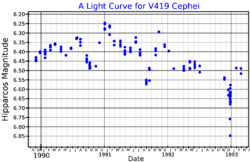Astronomy:V419 Cephei
| Observation data Equinox J2000.0]] (ICRS) | |
|---|---|
| Constellation | Cepheus |
| Right ascension | 21h 12m 47.24741s[2] |
| Declination | +60° 05′ 52.8017″[2] |
| Apparent magnitude (V) | 6.54 - 6.89[3] |
| Characteristics | |
| Evolutionary stage | Red supergiant |
| Spectral type | M2 Ib[4] |
| Variable type | Lc[3] |
| Astrometry | |
| Proper motion (μ) | RA: −2.515[5] mas/yr Dec.: −3.277[5] mas/yr |
| Parallax (π) | 1.0342 ± 0.1022[5] mas |
| Distance | 1,085[6] pc |
| Absolute magnitude (MV) | −5.72[7] |
| Details | |
| Mass | 16.6 ± 2.6[8] M☉ |
| Radius | 533[9] R☉ |
| Luminosity (bolometric) | 45,300 - 46,100[9] L☉ |
| Temperature | 3,660±170[9] K |
| Age | 10.0[8] Myr |
| Other designations | |
| Database references | |
| SIMBAD | data |
V419 Cephei (BD+59°2342 or HIP 104719) is an irregular variable star in the constellation of Cepheus with an apparent magnitude that varies between 6.54 and 6.89.
Distance
The Hipparcos-measured parallax of 0.63±0.29 mas is not constrained to evaluate its distance. Based on kinematic analysis, its most likely distance is 1,085±320 parsecs, equal to 3,540±1,035 light years.[6] The Gaia Data Release 2 parallax of 1.0342±0.1022 mas is consistent with this distance.[5] It is a member of the stellar association Cepheus OB2-A.[6]
Characteristics
V419 Cephei is a red supergiant of spectral type M2 Ib with an effective temperature around 3,700 K and an estimated radius of 533 R☉. The K-band angular diameter measurements equal 5.90 ± 0.70 milliarcseconds,[10] which leads to a figure not much higher, although the uncertainty in its distance must also be taken into account. If placed at the Sun's location, it would engulf the orbits of Mercury, Venus, Earth, Mars, and roughly half of the asteroid belt.
V419 Cephei has a mass 16.6 solar masses, above the limit beyond which stars end their lives as supernovae. The life of such massive stars is very short. Despite its advanced evolutionary state, V419 Cephei is only 10 million years old.[8]
Billed as an irregular variable star of type LC, V419 Cephei's brightness varies between magnitudes 6.54 and 6.89 with no apparent periodicity.[3]
References
- ↑ "Hipparcos Tools Interactive Data Access". ESA. https://www.cosmos.esa.int/web/hipparcos/interactive-data-access.
- ↑ 2.0 2.1 van Leeuwen, F. (2007). "Validation of the New Hipparcos Reduction". Astronomy and Astrophysics 474 (2): 653–64. doi:10.1051/0004-6361:20078357. Bibcode: 2007A&A...474..653V.
- ↑ 3.0 3.1 3.2 Samus, N. N. et al. (2009). "VizieR Online Data Catalog: General Catalogue of Variable Stars (Samus+ 2007-2013)". VizieR On-line Data Catalog: B/GCVS. Originally Published in: 2009yCat....102025S 1. Bibcode: 2009yCat....102025S.
- ↑ Keenan, Philip C.; McNeil, Raymond C. (1989). "The Perkins catalog of revised MK types for the cooler stars". Astrophysical Journal Supplement Series 71: 245. doi:10.1086/191373. Bibcode: 1989ApJS...71..245K.
- ↑ 5.0 5.1 5.2 5.3 Brown, A. G. A. (August 2018). "Gaia Data Release 2: Summary of the contents and survey properties". Astronomy & Astrophysics 616: A1. doi:10.1051/0004-6361/201833051. Bibcode: 2018A&A...616A...1G. Gaia DR2 record for this source at VizieR.
- ↑ 6.0 6.1 6.2 Famaey, B.; Jorissen, A.; Luri, X.; Mayor, M.; Udry, S.; Dejonghe, H.; Turon, C. (2005). "Local kinematics of K and M giants from CORAVEL/Hipparcos/Tycho-2 data. Revisiting the concept of superclusters". Astronomy and Astrophysics 405: 165. doi:10.1051/0004-6361:20041272. pp. 165-186. Bibcode: 2005A&A...430..165F.
- ↑ Table 4 in Levesque, Emily M.; Massey, Philip; Olsen, K. A. G.; Plez, Bertrand; Josselin, Eric; Maeder, Andre; Meynet, Georges (August 2005). "The Effective Temperature Scale of Galactic Red Supergiants: Cool, but Not As Cool As We Thought". The Astrophysical Journal 628 (2): 973–985. doi:10.1086/430901. Bibcode: 2005ApJ...628..973L.
- ↑ 8.0 8.1 8.2 Tetzlaff, N.; Neuhäuser, R.; Hohle, M. M. (2011). "A catalogue of young runaway Hipparcos stars within 3 kpc from the Sun". Monthly Notices of the Royal Astronomical Society 410 (1): 190–200. doi:10.1111/j.1365-2966.2010.17434.x. Bibcode: 2011MNRAS.410..190T.
- ↑ 9.0 9.1 9.2 Messineo, M.; Brown, A. G. A. (2019). "A Catalog of Known Galactic K-M Stars of Class I Candidate Red Supergiants in Gaia DR2". The Astronomical Journal 158 (1): 20. doi:10.3847/1538-3881/ab1cbd. Bibcode: 2019AJ....158...20M.
- ↑ Richichi, A.; Percheron, I.; Khristoforova, M. (2005). "CHARM2: An updated Catalog of High Angular Resolution Measurements". Astronomy and Astrophysics 431 (4): 773. doi:10.1051/0004-6361:20042039. pp. 773-777. Bibcode: 2005A&A...431..773R.
 |


